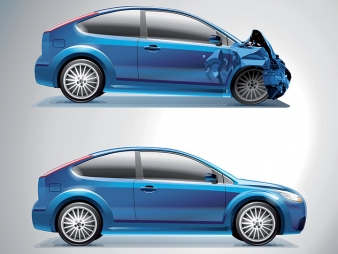Sitting at a light in your 2018 Ford F-150, waiting for it to change, you suddenly feel your head snap backwards as you hear the sound of breaking glass.
Although you are a little sore, you have escaped major injury. Your truck is not so lucky. Still, after thousands of dollars in repair, it is as good as new. Or is it?
A few months later when you try to trade in your 2018 model for the brand new 2020 Ford F-150, the dealer tells you he cannot give you full trade in value because your truck has an accident history. You explain that the truck was fully repaired and works just fine. Your dealer shrugs and says that the average consumer does not want to take that risk.
This phenomenon is known as diminished value. Diminished value has always been with us. If a consumer is choosing between two cars and knows that one of them has been in an accident, all other things being equal, she will choose the vehicle that has not been in an accident. The difference is that while in the past a person may not have known about a vehicle’s accident history, with advances in technology and through services such as CARFAX, almost every consumer knows whether your vehicle has been in an accident.
The good news is that the law in Ohio allows for people to be compensated for the loss in value to their vehicle. When your car is damaged in an accident that was caused by someone else’s negligence, you are entitled to not only the cost of repairs, but to any loss in value the vehicle suffers after the repairs have been made because the car now has an accident history.
The concept of diminished value is not new in Ohio. As early as the 1950s the Ohio Supreme Court recognized that that the owner of a damaged motor vehicle may recover the difference between its market value immediately before and its market value immediately after the collision. Falter v. Toledo, 169 Ohio St. 238, at ¶ 1 of the syllabus (1959). Some insurance company attorneys have tried to argue this decision means that if the vehicle was repaired you cannot recover for the loss in value because the vehicle has been fixed. Yet, all of the Ohio appellate courts that have considered the issue have rejected that position and specifically held that where a plaintiff can prove that the value of a damaged vehicle after repair is less than the vehicle’s worth before the accident, the plaintiff may recover both the reasonable cost of repair and the residual diminution in value after repair. See Braum v. Kinderdine, 2nd Dist. No. 26298, 2015‑Ohio‑696; Rakich v. Anthem Blue Cross & Blue Shield, 10th Dist. No. 06AP-1067, 2007-Ohio-3739, ¶19
Many insurance companies continue to pretend that the law in Ohio does not recognize diminished value claims. Some will admit that it exists, but minimize its impact. In such situations it is often advisable to consult with an attorney who can refer you to a reputable appraiser and help you with your claim.
Diminished value is a fact of our modern age. Getting an insurance company to accept that fact often requires help from an attorney.




